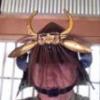There is actually not a lot of information even on Japanese sites when you run a search.
Many of the Bashin/Kankyuto that I have seen slip nicely into the Hitsu in the saya as if they were Kogai or two-sectioned Kozuka.
There seem to be a wide variety, however, and although they fall generally clearly into either Bashin (Horse needle) or Kankyu-to (Piercing blade) there are many examples which seem to be a mix of the two. They range from rudimentary to highly decorative and seem to be all different sizes. Some even look like miniature Yari spears with wooden hafts and a clear head. Japanese people, even if they've heard of Bashin, will not have heard of Kankyuto, and will certainly not be able to tell you what they were or how they functioned. Ninja favoured smaller hand-held versions of them too, apparently, and whereas J comics or TV dramas suggest the Kogai or Kozuka could be thrown, it was more likely the heavier bashin/kankyuto.
I bought a Bashin/Kankyuto out of curiosity the other day on the J auction and was annoyed to discover it was brand new but 'aged' cleverly. Very expensive lesson. There's a place called Seki in Japan which is making huge volumes of fake armour.
Following this I decided to buy a really good one with some lovely writing all over it. (Too good as it turns out and it turns out the signature is quite possibly a fake.) As someone pointed out, the Umabari is a Needle, and the Kankyuto ends with 'to' as in Nihonto, and has a proper blade, often double-sided. So mine is a Kankyuto, I reckon, even if everyone says "Look, a Bashin!"
Clearly the Bashin was a horse tool originally and with Japanese horses wearing straw sandals instead of horseshoes, highly necessary, I imagine.
The question about Kyushu is interesting and I look forward to hearing the answers, especially as I have a Higo gun!
I couldn't find anywhere on my armor/armour to keep my first Kankyuto, pushing it through the string on the Kote, etc., ... ended up shoving it into the saya hitsu where it sat quite happily!
Having spoken about their 'clear' differences however, the hole in the hilt is thought-provoking. This hole makes the Kankyuto a needle as well as a knife, and that is why I asked whether it was used for pushing a cord through the enemy's head. The Kanji for 'Kan' or 'Tsuranuku' means open a hole and push through from one side to the other, among other things.
Looking forward to this thread attracting all the information available!
Piers


